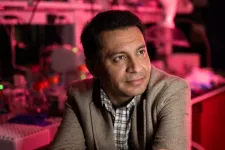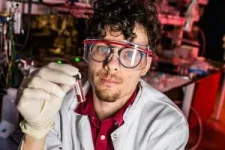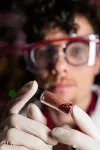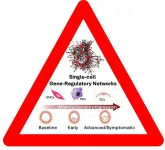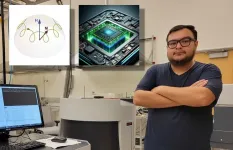(Press-News.org) EMBARGOED for release until 1pm U.S. Central Time (2pm Eastern) on June 13, 2024
HOUSTON – (June 13, 2024) – Solar power is not only the fastest growing energy technology in recent history but also one of the cheapest energy sources and the most impactful in terms of reducing greenhouse gas emissions.
A Rice University study featured on the cover of today’s issue of Science describes a way to synthesize formamidinium lead iodide (FAPbI3) ⎯ the type of crystal currently used to make the highest-efficiency perovskite solar cells ⎯ into ultrastable, high-quality photovoltaic films. The overall efficiency of the resulting FAPbI3 solar cells decreased by less than 3% over more than 1,000 hours of operation at temperatures of 85 degrees Celsius (185 Fahrenheit).
“Right now, we think that this is state of the art in terms of stability,” said Rice engineer Aditya Mohite, whose lab has achieved progressive improvements in the perovskites’ durability and performance over the past several years. “Perovskite solar cells have the potential to revolutionize energy production, but achieving long-duration stability has been a significant challenge.”
With this most recent breakthrough, Mohite and collaborators have reached a critical milestone toward making perovskite photovoltaics market-ready. The key was “seasoning” the FAPbI3 precursor solution with a sprinkling of specially designed two-dimensional (2D) perovskites. These served as a template guiding the growth of the bulk/3D perovskite, providing added compression and stability to the crystal lattice structure.
“Perovskite crystals get broken in two ways: chemically ⎯ destroying the molecules that make up the crystal ⎯ and structurally ⎯ reordering the molecules to form a different crystal,” said Isaac Metcalf, a Rice materials science and nanoengineering graduate student and a lead author on the study. “Of the various crystals that we use in solar cells, the most chemically stable are also the least structurally stable and vice versa. FAPbI3 is on the structurally unstable end of that spectrum.”
While more stable than FAPbI3 both chemically and structurally, 2D perovskites are typically not great at harvesting light, making them a poor choice of material for solar cells. However, the researchers hypothesized that 2D perovskites used as templates for growing FAPbI3 films might impart their stability to the latter. To test this idea, they developed four different types of 2D perovskites ⎯ two with a surface structure nearly indistinguishable from that of FAPbI3 and two less well-matched ⎯ and used them to make different FAPbI3 film formulations.
“The addition of well-matched 2D crystals made it easier for FAPbI3 crystals to form, while poorly matched 2D crystals actually made it harder to form, validating our hypothesis,” Metcalf said. “FAPbI3 films templated with 2D crystals were higher quality, showing less internal disorder and exhibiting a stronger response to illumination, which translated as higher efficiency.”
The 2D crystal templates improved not only the efficiency of FAPbI3 solar cells but also their durability. While solar cells without any 2D crystals degraded significantly after two days of generating electricity from sunlight in air, solar cells with 2D templates did not start degrading even after 20 days. By adding an encapsulation layer to the 2D-templated solar cells, stability was further improved to timescales approaching commercial relevance.
These findings could have a transformative impact on light-harvesting, or photovoltaic, technologies, further reducing manufacturing costs and enabling the construction of solar panels with a simplified structure that are lighter weight and more flexible than their silicon-based counterparts.
“Perovskites are soluble in solution, so you can take an ink of a perovskite precursor and spread it across a piece of glass, then heat it up and you have the absorber layer for a solar cell,” Metcalf said. “Since you don’t need very high temperatures ⎯ perovskite films can be processed at temperatures below 150 Celsius (302 Fahrenheit) ⎯ in theory that also means perovskite solar panels can be made on plastic or even flexible substrates, which could further reduce costs.”
Although it is the most widely used semiconductor in photovoltaic cells, silicon entails manufacturing processes that are more resource-intensive than those of emerging alternatives. Among these, halide perovskites stand out for their soaring efficiencies, which have gone from 3.9% in 2009 to over 26% currently.
“It should be much cheaper and less energy-intensive to make high-quality perovskite solar panels compared to high-quality silicon panels, because the processing is so much easier,” Metcalf said.
“We need to urgently transition our global energy system to an emissions-free alternative,” he added, pointing to United Nations’ Intergovernmental Panel on Climate Change estimates that “make a strong case for solar as an alternative to fossil fuels.”
Mohite underscored that advancements in solar energy technologies and infrastructure are critical for achieving the greenhouse gas emissions 2030 target and preventing a 1.5 degrees Celsius rise in global temperatures, which “would then set us on the right course to achieve net zero carbon emissions by 2050.”
“If solar electricity doesn’t happen, none of the other processes that rely on green electrons from the grid, such as thermochemical or electrochemical processes for chemical manufacturing, will happen,” Mohite said. “Photovoltaics are absolutely critical.”
Mohite is Rice’s William M. Rice Trustee Professor, a professor of chemical and biomolecular engineering, and faculty director of the Rice Engineering Initiative for Energy Transition and Sustainability. In addition to Metcalf, Siraj Sidhik, a Rice doctoral alumnus, is a lead author on the study.
“I would like to give a lot of credit to Siraj, who started this project based on a theoretical idea by Professor Jacky Even at the University of Rennes,” Mohite said. “I would also like to thank our collaborators at the national labs and at several universities in the U.S. and abroad whose help was instrumental to this work.”
Additional co-authors include researchers from several institutions in the U.S. and abroad, including Lawrence Berkeley National Laboratory; University of California, San Diego; University of Lille, National Center for Scientific Research (CNRS), Centrale Lille Institut; University of Artois; Northwestern University; Purdue University; University of Rennes, INSA Rennes, CNRS, Institut FOTON; Brookhaven National Laboratory; University of Washington; and Northwestern University.
The research was supported by the U.S. Department of Energy, the Hertz Foundation, the National Science Foundation, the Air Force Research Laboratory, the Office of Naval Research, the Army Research Office, the China Scholarship Council (202107990007), the Institut Universitaire de France and the German Science Foundation. The content in this press release is solely the responsibility of the authors and does not necessarily represent the official views of the funders.
-30-
This news release can be found online at news.rice.edu.
Follow Rice News and Media Relations via Twitter @RiceUNews.
Peer-reviewed paper:
Two-dimensional perovskite templates for durable, efficient formamidinium perovskite solar cells | Science | DOI: 10.1126/science.abq6993
Authors: Siraj Sidhik, Isaac Metcalf, Wenbin Li, Tim Kodalle, Connor Dolan, Mohammad Khalili, Jin Hou, Faiz Mandani, Andrew Torma, Hao Zhang, Rabindranath Garai, Jessica Persaud, Amanda Marciel, Itzel Alejandra Muro Puente, G. N. Manjunatha Reddy, Adam Balvanz, Muhammad A. Alam, Claudine Katan, Esther Tsai, David Ginger, David Fenning, Mercouri G. Kanatzidis, Carolin M. Sutter-Fella, Jacky Even and Aditya D. Mohite
https://doi.org/10.1126/science.abq6993
Image downloads:
URL: https://news-network.rice.edu/news/files/2024/06/Metcalf_Mohite.jpg
CAPTION: Isaac Metcalf (left) and Aditya Mohite (Photos by Jeff Fitlow/Rice University)
URL: https://news-network.rice.edu/news/files/2024/06/240416_Mohite_Fitlow_19181.jpg
CAPTION: Aditya Mohite is Rice University’s William M. Rice Trustee Professor, a professor of chemical and biomolecular engineering, and faculty director of the Rice Engineering Initiative for Energy Transition and Sustainability. (Photo by Jeff Fitlow/Rice University)
URL: https://news-network.rice.edu/news/files/2024/06/240416_Mohite_Fitlow_19212.jpg
CAPTION: Isaac Metcalf is a materials science and nanoengineering graduate student at Rice University and a lead author on a study featured on the cover of Science. (Photo by Jeff Fitlow/Rice University)
URL: https://news-network.rice.edu/news/files/2024/06/2Dperovskite-sample-1.jpg
https://news-network.rice.edu/news/files/2024/06/240416_Mohite_Fitlow_19218.jpg
https://news-network.rice.edu/news/files/2024/06/240416_Mohite_Fitlow_19264.jpg
CAPTION: “Seasoning” the FAPbI3 precursor solution with a sprinkling of specially designed two-dimensional (2D) perovskites improved not only the efficiency of FAPbI3 solar cells but also their durability. (Photos by Jeff Fitlow/Rice University)
URL: https://news-network.rice.edu/news/files/2024/06/240416_Mohite_Fitlow_19254.jpg
CAPTION: 2D perovskite sample (Photo by Jeff Fitlow/Rice University)
URL: https://news-network.rice.edu/news/files/2024/06/240416_Mohite_Fitlow_19261.jpg
CAPTION: 2D perovskite sample (Photo by Jeff Fitlow/Rice University)
Related stories:
Breakthrough synthesis method improves solar cell stability:
https://news.rice.edu/news/2023/breakthrough-synthesis-method-improves-solar-cell-stability
Solvent study solves solar cell durability puzzle:
https://news.rice.edu/news/2022/solvent-study-solves-solar-cell-durability-puzzle
Ultrathin solar cells get a boost:
https://news.rice.edu/news/2021/ultrathin-solar-cells-get-boost
Solar energy collectors grown from seeds:
https://news.rice.edu/news/2021/solar-energy-collectors-grown-seeds
Research could dramatically lower the cost of electron sources:
https://news.rice.edu/news/2021/research-could-dramatically-lower-cost-electron-sources
About Rice:
Located on a 300-acre forested campus in Houston, Rice University is consistently ranked among the nation’s top 20 universities by U.S. News & World Report. Rice has highly respected schools of architecture, business, continuing studies, engineering, humanities, music, natural sciences and social sciences and is home to the Baker Institute for Public Policy. With 4,574 undergraduates and 3,982 graduate students, Rice’s undergraduate student-to-faculty ratio is just under 6-to-1. Its residential college system builds close-knit communities and lifelong friendships, just one reason why Rice is ranked No. 1 for lots of race/class interaction, No. 2 for best-run colleges and No. 12 for quality of life by the Princeton Review. Rice is also rated as a best value among private universities by Kiplinger’s Personal Finance.
END
Rice lab achieves major gains in perovskite solar cell stability
Synthesis process boosts performance to near market-ready standards
2024-06-14
ELSE PRESS RELEASES FROM THIS DATE:
New mechanisms in the development of stroke were discovered
2024-06-14
A group of researchers from the University of Tartu and international scientists discovered new mechanisms of how stroke occurs by studying changes in mouse and human cells. The study lays the foundation for new, more precise treatment methods and better diagnostics, which could improve cardiovascular health in the future.
One of the authors of the study, a PhD student of Faculty of Medicine of University of Tartu Katyayani Sukhavasi said that affecting people of all ages, every fifth minute, someone suffers a stroke resulting in brain bleeding or ischemia. „Consequently, many people die ...
The BMJ Commission sets out manifesto for a healthier UK
2024-06-14
Long term thinking and stable, consistent policies are key to improving our nation’s financial prosperity and wellbeing, say experts on The BMJ Commission on the Future of the NHS as they set out their manifesto for a healthier UK.
The BMJ Commission brings together leading experts from medicine and healthcare to identify the key challenges and priorities and make recommendations aimed at ensuring that the vision of the NHS is realised.
Their key pledges of what they would do if they were in government are:
Reaffirming ...
Making ferromagnets ready for ultra-fast communication and computation technology
2024-06-14
RIVERSIDE, Calif. -- An international team led by researchers at the University of California, Riverside, has made a significant breakthrough in how to enable and exploit ultra-fast spin behavior in ferromagnets. The research, published in Physical Review Letters and highlighted as an editors’ suggestion, paves the way for ultra-high frequency applications.
Today’s smartphones and computers operate at gigahertz frequencies, a measure of how fast they operate, with scientists working to make them even faster. The new research has found a way to achieve terahertz frequencies using conventional ferromagnets, which ...
Homes, not offices: Researchers recommend changes to transit station area development after COVID-19
2024-06-14
A new report offers lessons for post-pandemic transit policy and planning. Notably, it calls for planners to downplay the role of offices in transit station areas and increase the opportunity for people to live in them. Researchers Arthur C. Nelson and Robert Hibberd published "Transit Station Area Development and Demographic Outcomes (PDF)," updating their longitudinal analysis of the impacts of development near transit stations.
The new report includes a foreword by U.S. Congressman Earl Blumenauer. An excerpt reads:
"In this report, Arthur ...
AI can help doctors make better decisions and save lives
2024-06-13
New York, NY [June 13, 2024]—Deploying and evaluating a machine learning intervention to improve clinical care and patient outcomes is a key step in moving clinical deterioration models from byte to bedside, according to a June 13 editorial in Critical Care Medicine that comments on a Mount Sinai study published in the same issue. The main study found that hospitalized patients were 43 percent more likely to have their care escalated and significantly less likely to die if their care team received AI-generated alerts signaling adverse changes in their health. ...
UMD awarded U.S. Department of State grant to expand education abroad
2024-06-13
COLLEGE PARK, Md. – The University of Maryland School of Public Health, together with Bowie State University, is expanding its study abroad options for marginalized faculty and students and for students who are Pell Grant recipients, in part due to a grant announced June 13 from the U.S. State Department. The schools were among a select 37 institutions nationwide to receive this 2024 grant.
The award will connect underrepresented faculty and students from both universities with opportunities to study global public health in Rwanda, focusing on countering violent extremism, prevention of emerging tropical infectious diseases, ...
Q&A: Finding varieties of corn that are adapted to future climates
2024-06-13
Corn is one of the planet’s most important crops. It not only provides sweet kernels to flavor many dishes, but it’s also used in oils, as a sweetener syrup, and as a feed crop for livestock. Corn has been bred to maximize its yield on farms around the world.
But what will happen under climate change? Research led by the University of Washington combined climate projections with plant models to determine what combination of traits might be best adapted to future climates. The study used projections of weather and climate across ...
Does exercise in greenspace boost the individual health benefits of each?
2024-06-13
By Ann Kellett, Texas A&M University School of Public Health
Health practitioners and fitness buffs have long known that regular physical activity offers numerous health benefits, including the prevention of chronic conditions such as cardiovascular disease, diabetes, some cancers and osteoporosis.
In addition, exercise enhances immune function and pain control, reduces fall risk and extends life expectancy. Mental health benefits include improved mood, reduced anxiety and decreased ...
New insights into the brain regions involved in paranoia
2024-06-13
New Haven, Conn. — The capacity to adjust beliefs about one’s actions and their consequences in a constantly changing environment is a defining characteristic of advanced cognition. Disruptions to this ability, however, can negatively affect cognition and behavior, leading to such states of mind as paranoia, or the belief that others intend to harm us.
In a new study, Yale scientists uncover how one specific region of the brain might causally provoke these feelings of paranoia.
Their novel approach — which involved aligning data collected from monkeys with human data — also offers ...
Privacy-enhancing browser extensions fail to meet user needs, new NYU Tandon School of Engineering study finds
2024-06-13
Popular web browser extensions designed to protect user privacy and block online ads are falling short, according to NYU Tandon School of Engineering researchers, who are proposing new measurement methodologies to better uncover and quantify these shortcomings.
Led by Rachel Greenstadt, professor in the NYU Tandon Computer Science and Engineering (CSE) Department, the team will present its study at the 19th ACM ASIA Conference on Computer and Communications Security, taking place July 1–5, 2024 in Singapore.
Through ...
LAST 30 PRESS RELEASES:
First Editorial of 2026: Resisting AI slop
Joint ground- and space-based observations reveal Saturn-mass rogue planet
Inheritable genetic variant offers protection against blood cancer risk and progression
Pigs settled Pacific islands alongside early human voyagers
A Coral reef’s daily pulse reshapes microbes in surrounding waters
EAST Tokamak experiments exceed plasma density limit, offering new approach to fusion ignition
Groundbreaking discovery reveals Africa’s oldest cremation pyre and complex ritual practices
First breathing ‘lung-on-chip’ developed using genetically identical cells
How people moved pigs across the Pacific
Interaction of climate change and human activity and its impact on plant diversity in Qinghai-Tibet plateau
From addressing uncertainty to national strategy: an interpretation of Professor Lim Siong Guan’s views
Clinical trials on AI language model use in digestive healthcare
Scientists improve robotic visual–inertial trajectory localization accuracy using cross-modal interaction and selection techniques
Correlation between cancer cachexia and immune-related adverse events in HCC
Human adipose tissue: a new source for functional organoids
Metro lines double as freight highways during off-peak hours, Beijing study shows
Biomedical functions and applications of nanomaterials in tumor diagnosis and treatment: perspectives from ophthalmic oncology
3D imaging unveils how passivation improves perovskite solar cell performance
Enriching framework Al sites in 8-membered rings of Cu-SSZ-39 zeolite to enhance low-temperature ammonia selective catalytic reduction performance
AI-powered RNA drug development: a new frontier in therapeutics
Decoupling the HOR enhancement on PtRu: Dynamically matching interfacial water to reaction coordinates
Sulfur isn’t poisonous when it synergistically acts with phosphine in olefins hydroformylation
URI researchers uncover molecular mechanisms behind speciation in corals
Chitin based carbon aerogel offers a cleaner way to store thermal energy
Tracing hidden sources of nitrate pollution in rapidly changing rural urban landscapes
Viruses on plastic pollution may quietly accelerate the spread of antibiotic resistance
Three UH Rainbow Babies & Children’s faculty elected to prestigious American Pediatric Society
Tunnel resilience models unveiled to aid post-earthquake recovery
Satellite communication systems: the future of 5G/6G connectivity
Space computing power networks: a new frontier for satellite technologies
[Press-News.org] Rice lab achieves major gains in perovskite solar cell stabilitySynthesis process boosts performance to near market-ready standards
